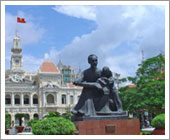 |
Vietnam Health Insurance
 |
|

The second-largest exporter of rice in the world, the densely
populated Socialist Republic of Vietnam, with an estimated
90.5 million inhabitants sits on a coastal stretch in
Southeast Asia, sharing land borders with Cambodia, China and
Laos. Blessed by nature, the country is bursting with
historical, culinary and cultural attractions, beautiful
vistas, spectacular white-sand beaches, bountiful rice fields
and mountainous regions. Visitors can experience the spiritual
and cultural heart of Vietnam, its tombs and temples, palaces
and pagodas and be welcomed by a graciously hospitable people.
The climate changes with the geography across its total land
area of 331,210 square kilometers, being tropical in the south
and monsoonal in the north which experiences a hot, rainy
season and a warm, dry season. Linguistically diverse,
Vietnamese is designated for official use however English is
progressively being favoured as a second language. Some
Chinese and French are spoken and several local dialects are
also used.
Despite Vietnamese Government statistics depicting that the
country’s labour force grows by more than one million every
year, the country has a low unemployment rate the envy of many
countries in the developed world, sustained by an economy
dominated by government entities, responsible for producing
approximately 40 percent of GDP. Along with rice, Vietnam’s
main exports also include seafood, coffee, clothing,
electronics and crude oil. Rapid economic growth has
encouraged significant urban migration and higher living
standards in Vietnam, although environmental degradation is of
concern in the capital, Hanoi and major cities due to growing
urban industrialization. Significant increases year-on-year of
visitor arrivals has encouraged the tourism industry to focus
on expanding activities and infrastructure, however regardless
of where one travels in Vietnam, be it in the cities or off
the beaten track, individuals can be exposed to a variety of
health risks, especially in the remote and mountainous
regions. For this reason, it is prudent to arrange a
comprehensive international medical insurance policy in order
to guarantee access to a standard of care otherwise
unavailable or unaffordable in Vietnam.
Vietnam Health Care and Insurance
The public healthcare system is overseen by Vietnam’s
Ministry of Health (MOH), which is responsible for managing
the network and delivery of provincial, district and community
health services. Primary, secondary and tertiary care is
delivered via village health workers, health centers, general
and specialized hospitals. Although investment in upgrading
infrastructure has resulted in some improvement in key health
indicators, Vietnam faces many challenges in providing
equitable access to quality healthcare and responding to the
changing needs of its rapidly urbanizing and emerging
middle-class population. Despite the country having better
health indicators than many with similar income levels, the
quality of services can vary significantly depending on where
an individual requires treatment. In the major cities,
international health clinics provide an acceptable level of
care for minor injuries and illnesses however adequate care
can be difficult to access in rural areas, where communicable
diseases still present a major public health risk, and the
distribution of services and medical personnel is inequitable.
Regardless of where treatment is provided in Vietnam,
immediate payment in cash is expected.
A national Vietnam health insurance scheme is available,
providing both obligatory and voluntary insurance coverage.
Contributing to the scheme is mandatory for salaried
employees, and employers also contribute a percentage of
employee wages. Free medical insurance is provided for
children under the age of six. Despite this scheme being in
place, the majority of medical treatment is still paid in cash
at the preference of hospitals wanting to avoid additional
paperwork and reimbursement delays, which inevitably accompany
the national scheme. In reality, the system dictates that more
attention and better care is awarded to those who pay cash,
and consequently limits access and the quality of care for
those who cannot. Due mainly to this much larger role and the
benefits associated with out-of-pocket expenditures, health
insurance coverage is low, at approximately 30 percent of the
population. The country has a relatively large health
workforce however the distribution of workers and their level
of skill are major constraints to delivery of services.
Specialists, nursing staff, pharmacists and hospital
management personnel are all in short supply.
Overcrowding of tertiary facilities is a problem, as
patients with minor ailments bypass primary care due to
perceived inadequacies of the public system. The challenges
involved in using public healthcare and a growing middle-class
have resulted in an increase in demand for private sector
care. A large number of private hospitals and clinics operate,
concentrated in the main cities and staffed by highly-skilled
professionals who have abandoned the public system in
preference of higher incomes. As is generally consistent with
private medical care abroad, the cost of treatment is
considerable therefore consideration should be given to
purchasing an expatriate health insurance policy, to offset
such costs.
While improvements in national health indicators have been
realized in heavily populated areas such as Hanoi and Ho Chi
Minh, remote and rural areas have not experienced such
improvements, struggling with limited medical facilities and
supplies. Health statistics for rural areas lag significantly
behind those for urban areas, especially in relation to
achieving the country’s Millennium Development Goals. The UN
Population Fund for example reports maternal mortality at 411
deaths per 100,000 live deliveries for ethnic minorities
living in remote regions where the majority of women deliver
at home without the attendance of skilled personnel. This is
compared to urban-dwelling Vietnamese and an overall maternal
mortality rate of 56 deaths per 100,000 live deliveries.
Estimated life expectancy in Vietnam is 69 years for men and
72 years for women.
 |
|
Vietnam's medical insurance industry is a fast paced ever evolving market however our staff are experts and at your disposal. |
Expatriates and Travelers in Vietnam
|
Vietnam Travel Insurance Concerns
According to travel advisories, the single greatest risk to an
individual’s health and safety in Vietnam is a traffic-related
accident. This is the leading cause of death, injury and
emergency medical evacuation for foreigners in Vietnam.
Statistics show that approximately 1,000 such deaths occur
each month, with motorbike riders and pedestrians the most
common victims. Injuries prompting emergency evacuation often
include severe head trauma. Driving can be hazardous as
vehicles are often poorly maintained, riders frequently travel
against the flow of traffic, cities are congested, road rules
are routinely ignored and traffic violations seldom enforced.
Driving after dark is particularly dangerous due to poorly lit
roads and large vehicles travelling at high speed without
lights. Extra caution is required in the countryside, as
livestock and pedestrians are forced to share the road.
Emergency services are theoretically available nationwide by
contacting 113 for police, 114 for fire or 115 for ambulance,
however emergency services are considered unreliable, and have
a narrow scope of trauma care. Given the likelihood an
emergency evacuation or repatriation is required for severe
injury in the event of an accident, arranging an international
medical insurance policy is prudent to avoid being forced to
remain in the country for medical care or treatment becoming
an undue financial burden.
A high level of personal safety awareness should be
maintained as Southeast Asia, including Vietnam has a
heightened threat of terrorism, with little warning of a
deteriorating security situation. Places of worship,
recreational events, public establishments and areas
frequented by foreigners could potentially become targets, and
caution is advised. Petty crime, particularly in the larger
cities is increasing. Pedestrians are at risk of bag-snatching
from motorcycle-mounted criminals, and some such cases have
resulted in injury. Public transport, markets and shopping
centers are common places for bag-slashing and thievery.
Former battlefields along the Laos border and in central
Vietnam are of risk due to unexploded landmines, therefore
staying to well-used roads and pathways in rural areas is
advised. Severe storms can result in flooding, landslides and
cause extensive damage to infrastructure, resulting in the
interruption of essential services. Since late 2011, heavy
rains have caused the Mekong Delta and the central region to
flood, and road conditions, especially toward the north of the
country have deteriorated. Travellers are therefore advised to
monitor weather and local news reports, and avoid disaster
areas.
Vietnam Expat Health Insurance
Medical care for minor illnesses or injuries can be found in Vietnam.
Facilities do not meet international standards however and
serious medical conditions will often require evacuation to
Singapore or Thailand. Medicines and equipment are frequently
in short supply and immediate cash payment is expected at the
time of treatment. An insurance policy can be arranged through
International Medical Insurance, which provides cover for you
whenever and wherever you travel. Globally transferable
policies deliver benefits for a range of medical needs, from
emergency evacuation and maternity services to doctors’ fees,
specialist consultations and medications. To guarantee access
to healthcare while in Vietnam, contact an International
Medical Insurance consultant to discuss your requirements.
|
 |

